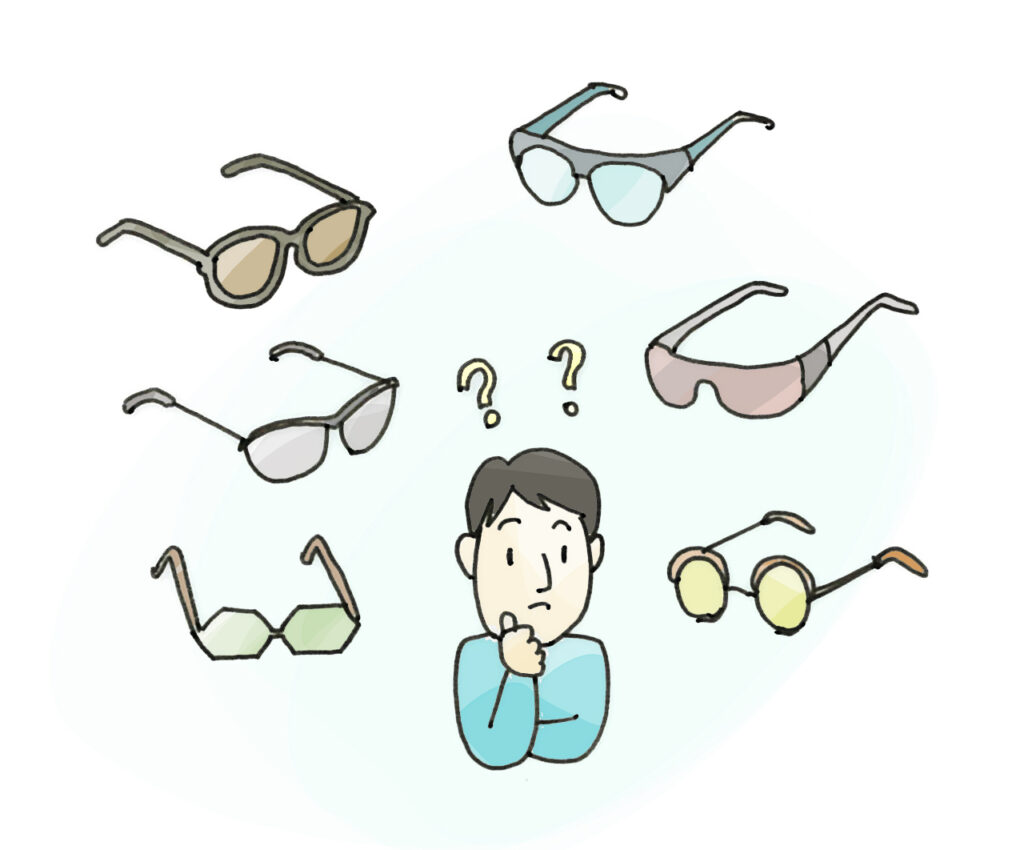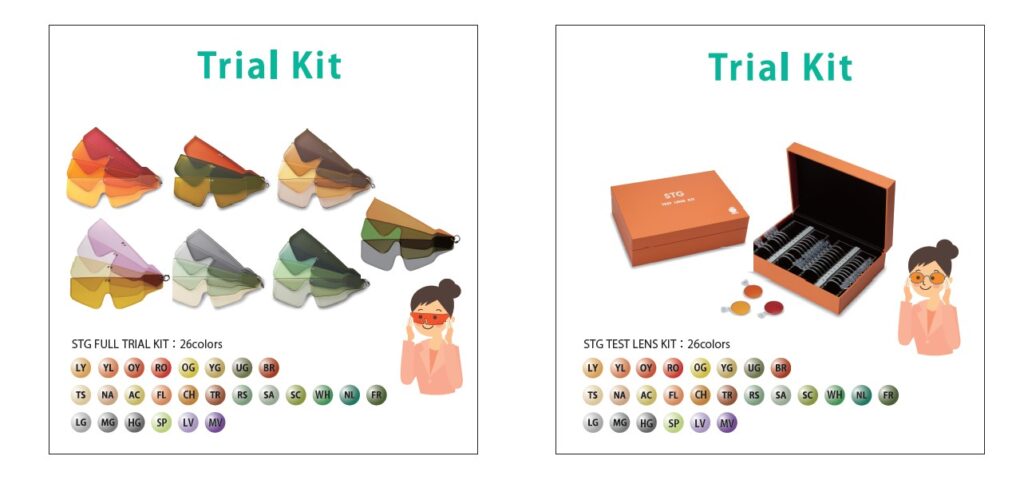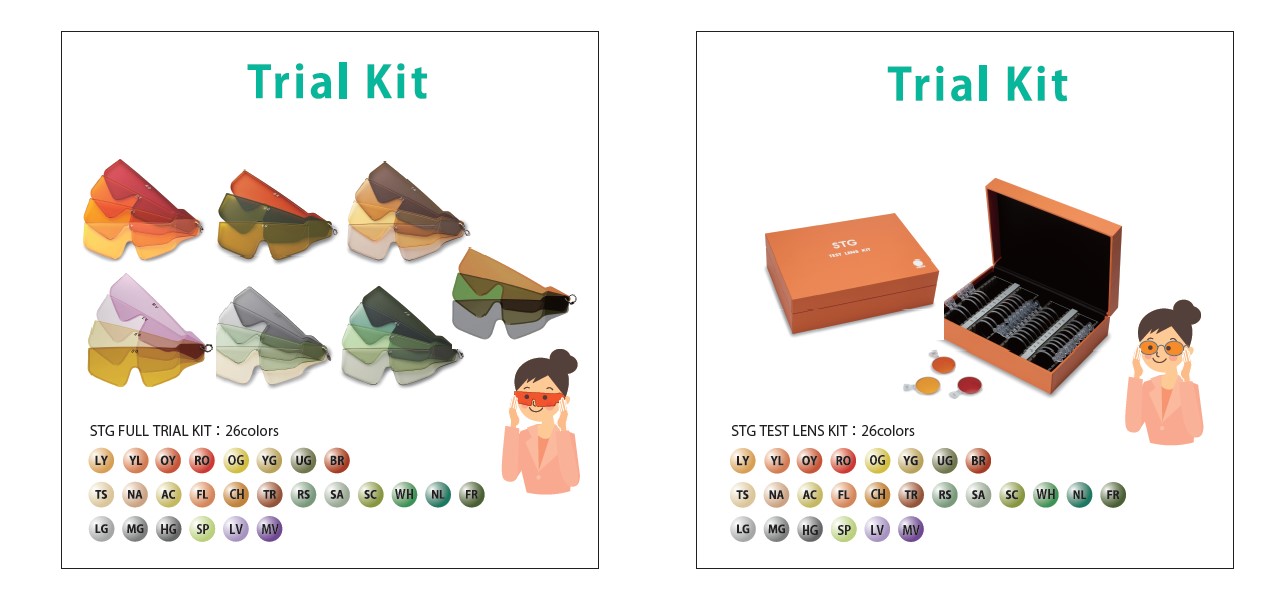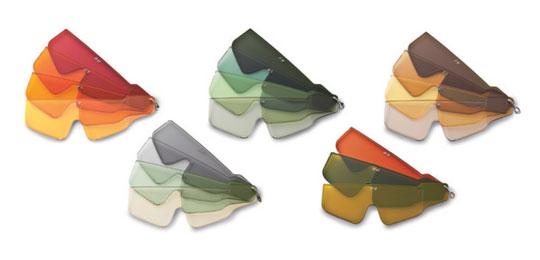“Absorptive Lens” are very effective tinted lenses (sunglasses) for those who feel glare. Originally developed to alleviate (relieve) glare to people suffering retinitis pigmentosa, Absorptive Lens are now used by all those who feel glare.
Note: The effect of Absorptive Lens differs between individuals and may not be ensured for all users.
The important point when using Absorptive Lens is “lens colors.” When customers select lens colors, they ask us questions, such as:
- Are lens colors limited depending on eye diseases?
- How can I select a lens color fit for me?
- What lens color suits me?
- Can I select a lens color that I like?
Now, let us answer these questions.
The visibility of things differs between individuals depending on the lens color!
The glare individuals feel differs between them, and so does the way they feel glare. Furthermore, the degree of glare also differs between individuals. Thus, the type and density of the color required for an individual will necessarily become different. This means that the color an individual selects depends on whether he/she feels easy to see things.

“Trial Kit” to be used when selecting a lens color
How should you select a lens color from among many colors? Use a dedicated Trial Kit to select the color of Absorptive Lens. When you see through the Trial Kit, you can check how the visibility of things changes, and the difference of contrast.

It is you who finally determine the color!
Who determines the color of Absorptive Lens? When selecting the color of Absorption lens, it is important for each eyeglass user to use this Trial Kit to try various lens colors and find the most effective one. That is, he/she determines the lens color himself/herself through a subjective inspection.
The first thing I want you to keep in mind is that “there is no color of Absorptive Lens that is determined by a symptom or disease.” The characteristics and symptoms of the eyes differ between individuals, and the degree of glare and the condition of the eyes are different, no matter what symptoms they have. This is the reason why selected colors and their densities are frequently different between individuals. Thus, when selecting a lens color, each eyeglass user is recommended to use a “dedicated Trial Kit” and try various lens colors.
Points when selecting the color of Absorptive Lens
- The difference of visibility resulting from colors differs between individuals, and other persons cannot recognize it.
- Use a dedicated Trial Kit to actually experience the difference of visibility between colors yourself.
- It is you who finally determine the color.
Points to note when selecting a lens color
1: Check whether glare is alleviated and whether contrast is enhanced. Check whether things look whitish or blurry due to glare.
Contrast refers to the difference between the brightness and darkness of a thing. For example, you can check it based on whether you can clearly see bumps in roads and lanes, white lines, crosswalks, and braille blocks on roads. Use Absorptive Lens to check whether symptoms are improved.

2: Check whether the field of vision is too dark and whether you feel fatigued when you wear eyeglasses.
In a dark place, visibility becomes poor, fatigue builds up due to concentration, and danger during walking increases. So, when selecting a lens color, it is necessary to see it that the field of vision does not become too dark. Check whether you feel danger on steps and staircases in places where a shadow is cast.
3: Try lens colors in an environment close to the actual use conditions to check whether they are appropriate.
It is ideal that the environment where you use a Trial Kit is similar to the environment where you use Absorptive Lens. For example, when your lenses are for indoor use, try them under an LED light; when your lenses are for outdoor use, try them actually outdoors. If sunlight is glaring, it is recommended to try lenses in the daytime on a sunny day. When you test the glare of a car’s headlights during the nighttime, perform it outdoors during the nighttime. When selecting a color, you can select a more effective one by checking colors in accordance with the environment where you actually use the Absorptive Lens.
To this end, it is important to set specific objects, such as “looking at a signboard” or “looking at a crosswalk,” to check the change of visibility. You will be able to feel the effect of the color of the light-shielding lenses through use in your daily life.
4: Check points to note during driving of a vehicle.
In a dark environment, a person’s eyesight drops, and the risk of misrecognition of traffic lights and signs rises. To prevent accidents, colors with a luminous transmittance of less than 75% cannot be used for driving and walking on roads during the nighttime. Furthermore, for driving during the daytime, you should not use colors that cut off almost all blue light of up to 500 nm because of the possibility of misrecognition of traffic lights.
5: Check whether you need to pay attention to the visual impression of the color of your Absorptive Lens in the environment where you use them.
Absorptive Lens are intended to improve the visual environment and make living safer and more worry-free. However, the colors of Absorptive Lens include many dark colors, and when using Absorptive Lens of dark colors in workplaces and schools, it is necessary for children in particular to acquire the understanding of teachers and other students. If the visual impression is significantly different between colors, it is also advisable to select a color with attention paid to how you look to others.
This is the end of the introduction of how to select colors of Absorptive Lens, and points to note about selection.
We would be glad if you could feel less strained or enjoy a safe and worry-free life by using Absorptive Lens that are selected with the visual environment placed as the foremost priority.
Please see the following page for product details.
Absorptive Lens



